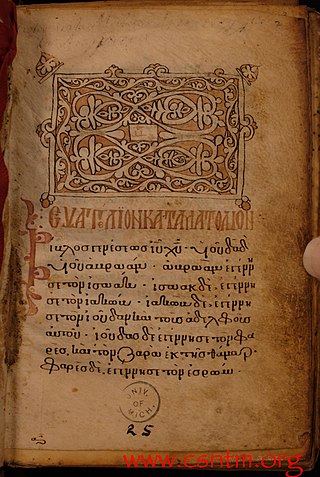Top Qs
Timeline
Chat
Perspective
Minuscule 544
New Testament manuscript From Wikipedia, the free encyclopedia
Remove ads
Minuscule 544 is a Greek minuscule manuscript of the New Testament Gospels, written on parchment. It is designated by the siglum 544 in the Gregory-Aland numbering of New Testament manuscripts, and ε337 in the von Soden numbering of New Testament manuscripts.[1] The manuscript has complex contents. Using the study of comparartive writing styles (palaeography), it has been assigned to the 13th century.[2] It was not adapted for liturgical use. Biblical scholar Frederick H. A. Scrivener labelled it as 557.[1]
It came from Epeiros and is currently housed at the University of Michigan. It was digitised and is available online.
Remove ads
Description
Summarize
Perspective
The manuscript is a codex (precursor to the modern book format), containing the text of the four Gospels written on 256 parchment leaves (size 13 cm by 9 cm). The text is written in one column per page, 22 lines per page.[2] It is neatly written in a minute hand. The style of writing has been considered to resemble the same in codex 542 (Scrivener's 555).[3]: L
The text is divided according to the chapters (known as κεφαλαια / kephalaia), whose numerals are given in the margin written in red ink, with the titles (known as τιτλοι / titloi) written at the top and bottom of the pages. There is also a division according to the smaller Ammonian Sections (in Mark 235 Sections, the last section in 16:12) in red, but no references to the Eusebian Canons (both early divisions of the Gospels into sections).[4][5] The κεφαλαια and the Ammonian Sections are often put in wrong places. There are no lectionary markings at the margin for liturgical use.[3]: L
It contains lists of the chapters (also known as κεφαλαια) to the last three Gospels, and pictures of the Evangelists: Matthew, Mark, and John.[5][4] Decorated head-pieces stand at the beginning of each Gospel.[3]: L It does not have lectionary markings in the margin (for liturgical use).[5] It contains the nomina sacra contracted in the usual way.
- Errors
Errors of iotacism (especially ει or ι for η, ο for ω, and vice versa) are rare in the first two Gospels, but more frequent afterwards.[3]: L The omissions by homoioteleuton (meaning "the same endings") are frequent (e.g. Matthew 10:37; Mark 9:43-46; 10:27.42; 12:39; 14:19; 15:14; Luke 10:27; John 3:31; 4:5; 5:32; 6:11.32.42; 8:14; 9:7; 12:34; 13:34; 14:17; 17:21).[3]: L Removal of the final-nu is very common, and though the punctuation is accurate, the sign of interrogation never occurs.[3]: L
This copy was transcribed from an older copy which was defective in Luke.[3]: L It has an unusual number of variations from the ordinary text, though none of the first rate of importance.[3]: LI
Remove ads
Text
Scholar Hermann von Soden classified the Greek text of the codex to his group Ia.[6] Biblical scholar Kurt Aland did not place it in any Category of his New Testament manuscript classification system.[7] According to the Claremont Profile Method (a specific analysis of textual data), it has an eclectic text. In Luke 1 it represents Πa, in Luke 10 a mixed Byzantine text, and in Luke 20 it reflects the text of Kx.[6]
- Some notable readings
- Matthew 2:19 — εν Αιγυπτω ] omitted
- Matthew 12:40 — καρδια ] κοιλια
- Matthew 16:21 — απο ] παρα
- Matthew 17:22 — ανθρωπων ] ανθρωπων αμαρτωλων
- Matthew 18:25 — ακρασιας ] αδικιας
- Matthew 18:28 — ανομιας ] αδικιας
- Mark 1:2 — εν τω ησαια τω προφητη ] εν βιβλω λογων ησαιου του προφητου
- Mark 8:14 — οπου ου δει ] εν τοπω αγνω
- Mark 14:3 — πιστικης ] μυστικης
- Mark 15:8 — καθως αει εποιει αυτοις ] τον βαραββαν (similar to Θ 565, and 700)
- Luke 1:48 — της δουλης ] του δουλου
- Luke 1:48 — κατα το ρημα σου ] omitted
- Luke 3:25 — του Μααθ του Ματταθιου ] omitted
- John 16:13 — το πνα της αληθειας ] omitted
- John 19:38 — του ιυ ] του κυ
Remove ads
History
- Location

Nothing is known of the codex's history until the year 1864, when it was in the possession of a dealer at Janina in Epeiros. It was then purchased from him by a representative of Baroness Burdett-Coutts (1814–1906), a philanthropist,[8] along with other Greek manuscripts (among them codices 532-546).[4] They were transported to England in 1870-1871.[9]
The manuscript was presented by Burdett-Coutts to Sir Roger Cholmely's School, and was housed at the Highgate (Burdett-Coutts III. 9), in London.[3] In 1922 it was acquired for the University of Michigan.[10] It is currently housed at the University of Michigan (shelf number Ms. 25) in Ann Arbor.[2]
- Examination
It was added to the list of New Testament manuscripts by scholars Scrivener and Caspar René Gregory.[5] Gregory saw it in 1883.[4]
Scrivener examined, described and collated its text. His collation was edited posthumous in Adversaria critica sacra in 1893.[3]: 61–162 It is rarely cited in the critical editions of the Greek New Testament.[11]
Gallery
- The first page of Mark with decorated headpiece
- Folio 54 verso with text of Matthew 22:32-44
- Folio 98 verso with text of Mark 8:31-38
- Folio 102 recto with text of Mark 9:42-10:4; verses 44 and 46 are omitted
See also
References
Further reading
External links
Wikiwand - on
Seamless Wikipedia browsing. On steroids.
Remove ads





